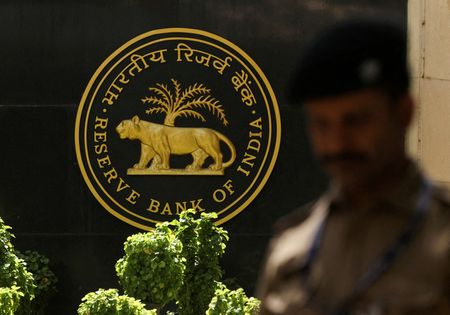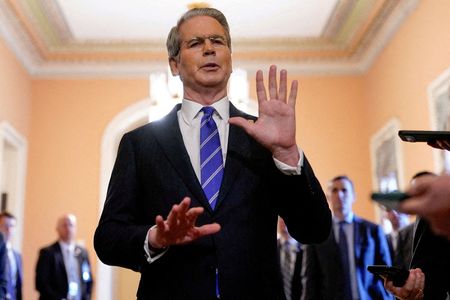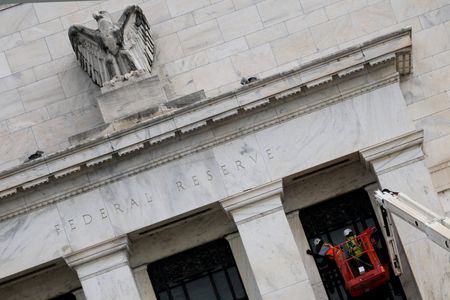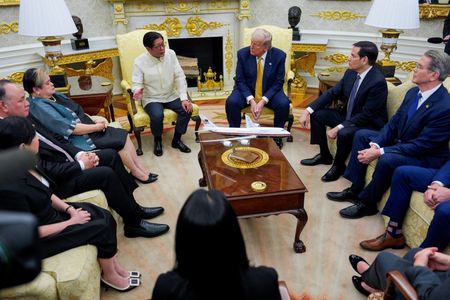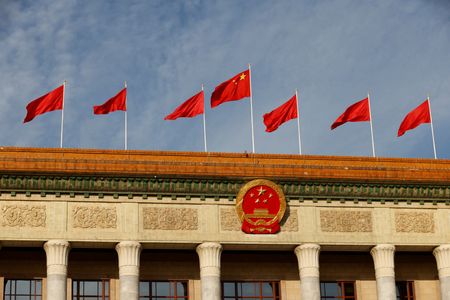By Swati Bhat and Sudipto Ganguly
MUMBAI (Reuters) – The Reserve Bank of India (RBI) cut its key interest rate for the first time in nearly five years on Friday, as it seeks to boost the sluggish economy and sees inflation easing towards its 4% target.
The Monetary Policy Committee (MPC), which consists of three RBI and three external members, cut the repo rate by 25 basis points to 6.25% after having kept it unchanged for eleven straight policy meetings.
The decision was in line with a Reuters poll, where over 70% of economists had predicted a quarter-point reduction, and marked the first reduction in India’s key rate since May 2020.
All six MPC members voted to cut the rate and to maintain the monetary policy stance at “neutral”.
The MPC noted that though growth is expected to recover, it is much lower than the 8.2% in 2023-24 and inflation dynamics have opened space for rate easing, RBI Governor Sanjay Malhotra said in the first policy review since his appointment in December.
Improving employment conditions, recently announced tax cuts, moderating inflation and good agricultural output after a strong monsoon will help growth, Malhotra said.
“The tremendous uncertainties that we are facing today, do not call us to change our stance, so our stance remains neutral,” Malhotra said in a press conference.
“This less restrictive policy is only for this particular MPC meeting, and not for going forward,” he said.
The governor’s comments suggest a rate cut at the April policy meeting “is not a done deal” and will depend on the economic situation at that point of time, said Murthy Nagarajan, head of fixed income at Tata Asset Management.
Most economists polled by Reuters ahead of the policy meeting had forecast Friday’s cut and only one more reduction of 25 bps in April, taking the policy rate down to 6%, though some market watchers such as Capital Economics and Nomura forecast several more cuts and say that rates will fall by 75-100 basis points in this cycle.
India’s benchmark 10-year bond yield rose six basis points to 6.71% after the announcement, as the rate cut was priced in to the market and the central bank skipped additional measures to ease tight liquidity, which bankers said would delay a pass-through of rate cuts.
India stocks markets and the rupee, which is hovering near record lows, were little changed.
WEAKER GROWTH, EASING INFLATION
India’s government has forecast annual growth of 6.4% in the year ending in March, below the lower end of its initial projection, weighed by a weaker manufacturing sector and slower corporate investments. That would be its slowest pace of expansion in four years.
Growth is seen in a 6.3%-6.8% range in the next fiscal year as well.
The central bank on Friday forecast growth of 6.7% next year.
“India can achieve growth of 7% or more; we should aspire for that,” Malhotra said.
Though retail inflation is still well above the RBI’s medium-term target of 4%, it eased to a four-month low of 5.22% in December and is seen gradually declining towards the target in coming months.
The central bank sees inflation averaging 4.8% in the current financial year, easing to 4.2% next year.
Food inflation pressures are expected to ease, Malhotra said, but added that volatile global energy prices pose a risk to the inflation outlook.
Core inflation, though likely to rise, will remain moderate, Malhotra said.
Tax cuts announced by the Indian government in its budget last week will not be inflationary, said Malhotra, who was earlier a top official in the federal ministry of finance.
BALANCING TRADE-OFFS
Malhotra used his first policy announcement to lay down the central bank’s priorities, suggesting a shift from the tight banking regulations pursued under predecessor Shaktikanta Das.
“There are trade-offs between stability and efficiency,” Malhotra said, referring to draft rules which propose to raise capital requirements for bank lending to under-construction infrastructure projects and raise the liquidity requirement against digital deposits.
“It will be our attempt to strike the right balance, keeping in view the benefits and costs of each and every regulation,” he said.
Some of these rules were to be implemented by March 31 but Malhotra said the timeline would be extended by at least one year.
The Indian government in rare public comments had said tight banking regulations were responsible for part of the slowdown and officials had privately advised against the new rules, Reuters reported last year.
Since Malhotra has taken over, the rupee like other emerging market currencies has weakened in the face of a stronger U.S. dollar and volatility has risen, prompting markets to speculate that the central bank was easing its grip on the currency.
Malhotra stuck to the long-held position of the central bank that interventions are only intended to smoothen “excessive and disruptive volatility rather than targeting any specific exchange rate level or bank”.
The central bank was likely selling dollars to support the rupee ahead of the policy announcement, traders said.
(Reporting by Swati Bhat and Sudipto Ganguly; additional reporting by Siddhi Nayak and Dharamraj Dhutia; writing by Ira Dugal; Editing by Savio D’Souza and Kim Coghill)

